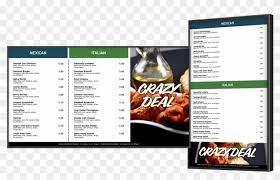Menu Board Software
The menu board software is a type of software that allows businesses to create and display digital menus on screens, such as TVs, tablets, and computers. These menus can be used to display food and drink options, prices, and other relevant information in restaurants, cafes, and other food service establishments. Some menu board software also offers additional features, such as the ability to update prices in real-time, create custom graphics and designs, and integrate with point-of-sale (POS) systems to track sales and inventory.
There are a variety of menu board software options available, with different features and pricing plans. Some popular options include:
- Rise Display: This software allows businesses to create custom menu boards and displays using a drag-and-drop editor. It also offers integrations with POS systems and the ability to update prices in real-time.
- QuickMenu: This software offers a range of templates and design tools for creating professional-looking menus. It also includes features such as the ability to schedule menu updates and create custom promotions.
- Digital Menu Board: This software allows businesses to create and display menus on TVs, tablets, and other screens. It includes tools for creating custom graphics and designs, as well as the ability to update prices and promotions in real time.
Before selecting a menu board software, it’s important to consider the specific needs of your business and the features that are most important to you. Some key factors to consider include the ability to customize menu layouts and designs, integration with POS systems, and the ability to update prices and promotions in real time.
What Is Menu Board Software:
The menu board software is a type of software that allows businesses to create and display digital menus on screens, such as TVs, tablets, and computers. These menus can be used to display food and drink options, prices, and other relevant information in restaurants, cafes, and other food service establishments. Menu board software typically includes tools for creating custom menu layouts and designs, as well as the ability to update prices and promotions in real time. Some menu board software also offers additional features, such as the ability to schedule menu updates and create custom promotions, and integration with point-of-sale (POS) systems to track sales and inventory.
Menu Board Software Pros:
There are several benefits to using menu board software to create and manage digital menu boards:
- Flexibility: With menu board software, you can easily update prices, change specials, and modify menu items without having to physically change the board. This allows you to make quick changes to your menu as needed.
- Increased accuracy: Digital menu boards are less prone to errors than physical boards, as they allow you to easily proofread and double-check your menu before publishing it.
- Enhanced visual appeal: Digital menu boards allow you to use high-quality images and videos to showcase your products, making your menu more visually appealing to customers.
- Increased efficiency: With menu board software, you can schedule menu updates in advance, reducing the time and effort required to manage your menu.
- Cost savings: Digital menu boards are often more cost-effective than physical boards, as they do not require printing and installation costs.
- Improved customer experience: Digital menu boards can provide customers with more detailed information about menu items, such as nutritional information or ingredient lists, improving the overall customer experience.
Cons:
There are also some potential drawbacks to using menu board software:
- Dependence on technology: Digital menu boards rely on technology, so if there are any issues with the software or the display device, it could affect the accuracy and availability of your menu.
- Initial setup and implementation costs: While digital menu boards may be more cost-effective in the long run, there may be upfront costs associated with purchasing and setting up the necessary hardware and software.
- Training and maintenance: Staff may need to be trained on how to use the menu board software, and the software may require regular updates and maintenance to ensure it is functioning properly.
- Limited reach: While digital menu boards can be a great way to reach customers in your establishment, they may not be as effective at reaching potential customers who are not physically present.
- Limited accessibility: Depending on the hardware and software used, digital menu boards may not be accessible to all customers, such as those with visual impairments.
- Limited customization: Some menu board software may not offer as much customization as physical boards, limiting your ability to create a unique and personalized menu display.
Conclusion:
In conclusion, menu board software can offer a number of benefits for businesses, including increased flexibility, accuracy, visual appeal, and efficiency. However, it is important to carefully consider the potential drawbacks and ensure that the software and hardware used are reliable and suitable for your needs. Ultimately, the decision to use menu board software will depend on the specific needs and goals of your business.



